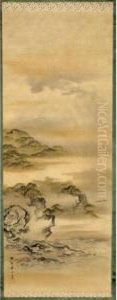Kano Toshinobu Paintings
Kano Toshinobu was a Japanese artist born in 1883, whose life and career spanned an era of significant transformation in Japan as it modernized and opened to Western influences. Despite the rapid changes in Japanese society and culture during this period, Toshinobu remained deeply rooted in the traditional styles and techniques of Japanese art, particularly within the Kano school of painting, which had been influential since the late Muromachi period (1336–1573). The Kano school was known for its rigorous training methods and adherence to a style that emphasized refinement, elegance, and a profound respect for nature, all of which are evident in Toshinobu's work.
Toshinobu's artistic output reflects a blend of the traditional with the new influences that were permeating Japanese art at the time. He was adept at the yamato-e style, characterized by its detailed depiction of classical Japanese themes, as well as the more Chinese-influenced kanga style, which focused on landscapes and nature using ink wash techniques. This ability to navigate between styles allowed Toshinobu to create works that were both deeply traditional and refreshingly innovative. His paintings often featured landscapes, flora and fauna, and historical themes, executed with a precision and delicacy that made his work highly sought after.
Throughout his career, Toshinobu contributed to the preservation and continuation of traditional Japanese artistic principles while also engaging with the cultural shifts occurring around him. He was involved in various exhibitions that aimed to promote Japanese art both domestically and internationally, helping to elevate the status of Japanese painters in the global art community. Despite the challenges of working during a period of great change, Toshinobu's dedication to his craft and his ability to adapt were key to his success.
Toshinobu passed away in 1935, leaving behind a legacy that continues to influence Japanese art. His work is celebrated for its technical prowess, its beauty, and its embodiment of the transitional period in which he lived. Through his paintings, Kano Toshinobu captured the essence of Japanese tradition while also embracing the evolving cultural landscape, making him a pivotal figure in the history of Japanese art.
